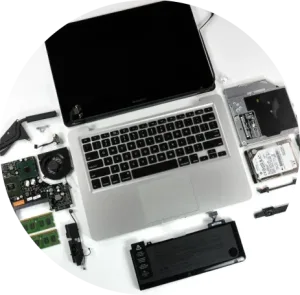A sticky key on your MacBook Air can disrupt your typing efficiency. To fix this, start by identifying the problem key, then shut down your MacBook Air. For initial cleaning, you can use compressed air without applying too much pressure. For visible crumbs, gently remove them by hand.
Then, remove the keycap and, using a flashlight, look for dust and debris buildup under the key. Finally, reattach the keycap, ensuring it fits properly into the designated space. If these steps don’t work, reach out to a certified MacBook repair technician for professional help.
Steps to Fix a Sticky Key on Your MacBook Air
Follow these steps to fix your MacBook’s sticky keys:
1: Identify the Problem Key and Its Behavior
First, check if the key feels sticky, fails to return smoothly, registers multiple inputs with a single press, or only responds when pressed firmly. This helps determine if it is a debris issue, a mechanical failure, or a result of a previous spill affecting the mechanism.
2: Shut Down Your MacBook Air
Before starting, power down your MacBook Air completely and unplug all connected accessories. To prevent scratches, always work in a clean, well-lit space with a soft cloth or mat.
3: Use Compressed Air for Initial Cleaning
Apple recommends using compressed air for minor debris under keys:
- Hold your MacBook Air at a 75-degree angle.
- Attach the straw nozzle to the can of compressed air.
- Spray in a left-to-right motion across the affected key.
- Rotate the MacBook Air to its right side and repeat.
- Rotate to its left side and repeat.
- Test the key afterward to check if the stickiness is resolved.
4: Inspect for Visible Debris
If compressed air does not resolve the issue, visually inspect the sticky key for:
- Crumbs
- Dust buildup
- Hair or lint
Use a flashlight for a clear view, especially around the key edges.
5: Remove the Keycap Carefully (If Necessary)
If there is debris under the key, then carefully remove the keycap.
For the scissors-switch keyboard (2018 and new MacBook Air):
- Gently pry from the top edge.
- To prevent breaking the clip, apply a little pressure.
For butterfly-switch keyboard (2015-2017 MacBook Air):
- Excessive care is required as butterfly switches are delicate.
- To prevent damage, use compressed air for cleaning.
6: Clean Under the Keycap
Once removed:
- Use a soft brush or a clean microfiber cloth to remove visible debris.
- Avoid using liquids directly on the keyboard.
- Use a lightly dampened cotton swab with isopropyl alcohol (70% or higher) around the edges to ensure no excess liquid seeps into the mechanism.
- Let the area dry completely before reassembling.
7: Reattach the Keycap
After cleaning:
- Align the keycap carefully with its hinges and clips.
- Gently press down until you hear a soft click.
- Test the key’s movement to confirm its functioning.
If it feels uneven, remove it and reposition to ensure proper alignment.
8: Addressing Sticky Keys After Liquid Spills
Liquid spills are a common cause of sticky keys. In case of a spill:
- Immediately power off the MacBook Air.
- Turn it upside down to prevent liquid from seeping further.
- Allow it to dry in a well-ventilated area for at least 48 hours.
- If keys are still sticky after drying, residue may remain under the mechanism.
It is advisable to seek professional cleaning for spills to prevent internal corrosion.
9: Software Troubleshooting for Sticky Keys
Sometimes, keyboard settings or system issues can mimic sticky key behavior:
- Navigate to System Settings > Accessibility > Keyboard.
- Check if “Sticky Keys” is enabled and then disable it.
- Run a keyboard test in Notes or TextEdit to monitor key behavior.
Reset the SMC (System Management Controller) and NVRAM if keyboard responsiveness issues persist:
- SMC Reset: Shut down, then press Shift + Control + Option + Power for 10 seconds.
- NVRAM Reset: Restart and immediately press Option + Command + P + R for 20 seconds.
10: Seek Professional Help
If you have tried cleaning and testing, but:
- The key remains sticky even after thorough cleaning.
- The keycap, hinge, or underlying surface is visibly damaged.
- The key does not register consistently or feels loose when pressed.
- Multiple keys are affected, making typing difficult.
It is time to seek professional help. For the MacBook Air, Apple and authorized MacBook Air repair service providers can replace individual keycaps and mechanisms on scissor-switch models. However, due to the integrated design, a full replacement is often required with butterfly keyboards.
If a liquid spill has caused the sticky keys, professional servicing can also help clean internal components to prevent corrosion and further keyboard failures. Getting a professional assessment ensures the keyboard is repaired correctly and prevents additional damage, saving you from unexpected malfunctions later.
Conclusion
A sticky key on your MacBook Air is due to stuck debris or mechanical wear. Start by cleaning with compressed air after inspection for debris. Quickly addressing minor issues can restore typing convenience and prevent further damage. In cases of persistent mechanical defects, professional MacBook Air repair services can restore your keyboard’s function.

